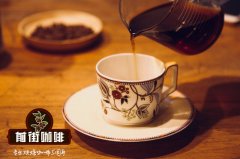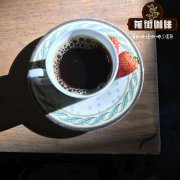Flavor of water washing bourbon in Rwanda Coca Kaka Cooperative Koakaka Coop | Mugansha treatment Plant

Professional coffee knowledge exchange more coffee bean information please follow the coffee workshop (Wechat official account cafe_style)
Rwanda Coca Kaka Cooperative Koakaka Coop | what is the flavor of the water washing bourbon in the Mugansha treatment plant?
The Cocaca Cooperative (Koakaka Coop), founded in 2002, is located in the south of Rwanda (Rwanda), adjacent to the natural rainforest (the Nyungwe rainforest). At that time, only three coffee growers (Karama, Kiyamakara and Rukondo) set up with the same mind. Today, there are only a small number of members, belonging to small-scale planting members, with an average member planting area of only 0.25ha, or an average of 300 coffee trees. The Coca-Cola Cooperative (Koakaka Coop) has a total of two washing plants, one named Karambi, in Huey and and, and the other is the Mugansha processing Plant (Muganza CWS), which is this batch of raw coffee beans. In addition, the cooperative is building a third water treatment plant.
In Rwanda, located in the heart of the interior of Africa, coffee was introduced by German missionaries in 1904 and flourished as a source of income for farmers in the 1930s. Coupled with the order of the government at that time, the increase in coffee production, although the quality was not good, it was still helpful to the economy at that time. With the outbreak of genocide in Rwanda in 1994, coffee cultivation technology and knowledge also disappeared, and the sharp decline in coffee prices around the world had a huge impact on the coffee industry. The top 10 coffee producing countries in the world, mostly concentrated in South America, Southeast Asia and Africa, especially Africa, as the hometown of coffee, have been hoping to expand the international market. Among them, the small Central African country of Rwanda, because of its small land, could not win the planting area by quantity, so it turned to boutique coffee, specializing in "all-washed" coffee beans, which compared with traditional sun-dried coffee beans. Washed raw beans can be sold with turnips and pure flavor, but expensive 1 kg beans need 10 liters of water to wash, and the final screened raw beans are no more than 200 grams, but Rwanda relies on strategic transformation. Relying on the export of coffee alone can earn US $60 million in foreign exchange a year, making it the new favorite of international boutique coffee. Rwanda can be said to be a fast-growing boutique coffee producer in East Africa, and apart from the vivid memories of its sad story of the massacre in Rwanda, the quality of its boutique coffee has improved rapidly.
Rwanda's goal is to re-establish at a steady pace the infrastructure needed for the production and processing of premium coffee beans in its coffee industry, most notably the Joint strengthening of the Rwanda Agricultural Partnership (PEARL), mainly to assist Rwanda in rebuilding agricultural institutions, production capacity and nurturing agricultural talent to help small local farms sell coffee beans directly to buyers in the boutique coffee market. Unlike neighboring countries such as Kenya and Ethiopia, Rwanda has a centralized system, but its agricultural cooperatives can buy and sell directly with buyers; at present, coffee has become a major export of Rwanda. In addition to exporting good coffee to the world, Rwanda has also begun to cultivate its domestic market and develop local brands, hoping to give people a taste of the rich aroma of the land.
Production area: Niamagabe County (Nyamagabe) area, Southern Province
Producer: Coca Card Co-operative Society (Koakaka Coop)
Treatment plant: Mugansha treatment plant (Muganza CWS)
Haiba: an average of 1700 to 1800 meters
Variety: bourbon species
Treatment: washing treatment
Flavor description: coffee berries, peaches, orange fruit notes, cream, cocoa
Spices, sour, round, delicate and juicy
Qianjie recommended cooking:
Filter cup: Hario V60
Water temperature: 90 degrees
Degree of grinding: small Fuji 3.5
Cooking methods: the ratio of water to powder is 1:15, 15g powder, the first injection of 25g water, 25 s steaming, the second injection to 120g water cut off, waiting for the powder bed water to half and then water injection, slow water injection until 225g water, extraction time about 2:00
Analysis: using three-stage brewing to clarify the flavor of the front, middle and back of the coffee. Because V60 has many ribs and the drainage speed is fast, it can prolong the extraction time when the water is cut off.
Important Notice :
前街咖啡 FrontStreet Coffee has moved to new addredd:
FrontStreet Coffee Address: 315,Donghua East Road,GuangZhou
Tel:020 38364473
- Prev

Huila Ulla province of Colombia | Garson Coocentral small farmers' cooperative wash Kaddura, brother
Professional coffee knowledge exchange more coffee bean information please follow the coffee workshop (Wechat official account cafe_style) Colombia Huila Kula province | Garson Coocentral small farmers cooperative washing Kaddura, Colombian variety flavor? The Coocentral small Farmers' Cooperative, located in Garzon Town, Ulla Province, has been composed of 55 members since its inception in 1975.
- Next

Introduction to the flavor characteristics of Guatemala LA Fortuna coffee by hand.
Professional coffee knowledge exchange more coffee bean information please follow the coffee workshop (Wechat official account cafe_style) back to the lake, La Fortuna at Atitlan is a group of solar ecological cabins with a great sense of design in the dense forest. All the building materials and most of the decorations are made from local plants, and the interior space is compact but quite comfortable. You can see the bathtub in the open air.
Related
- Detailed explanation of Jadeite planting Land in Panamanian Jadeite Manor introduction to the grading system of Jadeite competitive bidding, Red bid, Green bid and Rose Summer
- Story of Coffee planting in Brenka region of Costa Rica Stonehenge Manor anaerobic heavy honey treatment of flavor mouth
- What's on the barrel of Blue Mountain Coffee beans?
- Can American coffee also pull flowers? How to use hot American style to pull out a good-looking pattern?
- Can you make a cold extract with coffee beans? What is the right proportion for cold-extracted coffee formula?
- Indonesian PWN Gold Mandrine Coffee Origin Features Flavor How to Chong? Mandolin coffee is American.
- A brief introduction to the flavor characteristics of Brazilian yellow bourbon coffee beans
- What is the effect of different water quality on the flavor of cold-extracted coffee? What kind of water is best for brewing coffee?
- Why do you think of Rose Summer whenever you mention Panamanian coffee?
- Introduction to the characteristics of authentic blue mountain coffee bean producing areas? What is the CIB Coffee Authority in Jamaica?

